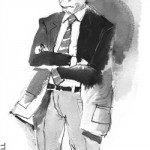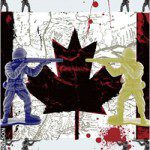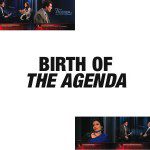Life of Brian
In a remarkable journey from steel town to tinsel town, Brian Linehan’s star rose steadily then fell abruptly. Now, in an era when the media have become willing enablers of celebrity puffery, his dedication to probing questions and in-depth research looks even more impressive

A 1982 Woody Allen interview went well but a $5-million lawsuit followed in New York. Allen claimed he originally stipulated that the interview not air in the Big Apple
On November 16, 1986, Brian Linehan lounged in a wooden chair in Tucson, Arizona, and interviewed Three Amigos!star Martin Short for City Lights, an in-depth Citytv celebrity-interview show. Always classy in grooming and attire (he never owned a pair of jeans in his life), Linehan asked the probing questions that showed off the impeccable research he was so famous for. “Have you been telling producers of your passion, I mean the dream to go back to those days in Hamilton in the attic and The Martin Short Show when you thought the coolest thing in the world was to be Frank Sinatra and introduce your special guest on The Martin Short Show? Do the producers know you want to do a movie musical or a Broadway musical?” Besides having an authoritative knowledge of Short’s childhood experiences and early career, Linehan spoke with an intimacy usually reserved for close friends. “Are you a Canadian in California or are you adapting? What’s happening with Nancy and the two children? Are you commuting?”
In return, Short spoke with an ease and openness that’s rare in celebrity interviews today. Once the cameras were off, they behaved like two young boys whose mothers had left them alone. Short scooted up to the edge of his seat and whispered excitedly during every commercial break. During one, he confided in Linehan his frustration about how he felt ignored by the Canadian press:
“Are we rolling?” Short asked.
“Are we on?” Linehan asked the crew, and was assured they weren’t.
“When the Americans would sit here,” he leaned in toward Linehan and lowered his voice, “they would talk to Steve, Chevy and I. When the Canadians would sit here, they would just talk to Steve and Chevy.” Short laughed.
“Really.”
“It’s like — I’m the Canadian! But there’s….” The production crew interrupted them and the conversation stopped.
Linehan developed this kind of rapport through years of meticulous research, accurate reporting and a genuine passion for his craft — a type of rapport that no longer exists in Canadian celebrity journalism today. He set a standard for celebrity interviewing and reporting that no one has matched. In fact, as today’s bevy of junketeers and sound bite grabbers from L.A. to Hollywood North prove daily, Linehan’s work ethic seems to have died with him in 2004.
Brian, you’ve said that you owed your start to Citytv. “If stations like City didnot exist,” you told journalist John Hofsess in a 1977 interview, “I would neverhave been given a chance. I wasn’t a radio or TV arts major. I never took actingor voice lessons or practiced sounding like Lorne Green.” What was it, then, thatmotivated you to step up and fill in for that first interview?
Linehan was born in Hamilton, Ontario, on September 3, 1944 — not in 1945, as reported by the Canadian Who’s Who. It’s a detail, credited to a Linehan white lie, which sifted the good reporters from the mediocre ones after his death. A private man, Linehan had his fun with the media, lying about his age and completely fabricating childhood anecdotes. Fact checkers couldn’t keep up with him.
The truth is Linehan was one of seven children, five boys and two girls, born to an Irish steelworker and a Serbian housewife when Hamilton was booming with steel production. One of his brothers, Patrick, now 59, has himself recently retired from a career of working in the mills. In a modest country-style home, Patrick repeatedly shoos one of his daughter’s cats off the dining room table while telling stories of Linehan keeping him awake at night by constantly talking about actors. But it was with his sister, Connie Kataric, that Linehan was closest. Kataric lives in Hamilton and still cries when she talks about her brother. She remembers him as the odd one out in the family — he preferred reading entertainment magazines while his other brothers were out playing sports.
“He was always into movies,” remembers Ted Hammond, a high school friend of Linehan’s, who also worked as co-editor with him on Omnia, the student paper at Delta secondary school. “Back in those days, the movie theatres in Hamilton gave out a gold pass once a year for anybody in the city who could select the most Academy Award winners. Brian was a teenager, and he won it two years in a row in the early ’60s.” AtOmnia, Hammond found Linehan obsessive. “He’d spend hours and hours doing research for one story. And that spun off later on. That was his thing. I thought he was too narrow focused that way, just doing research. I never thought that would help him the way it did.”
Journalist Philip Marchand hinted at a darker side to Linehan’s childhood. In a 1981 Chatelaine profile, he wrote, “Linehan speaks without bitterness of his childhood, but behind the style and the wit and the courtly manners of his presence, it is clear that something from that past, something in his bloodstream, won’t let him go.”
Michael Levine was Linehan’s close friend, lawyer and executor of his estate. He says Linehan confided in him about his family difficulties. “He came from a group of Irish- Yugoslavs who all worked in the steel mills. For Brian to be a gay man in a steelworker town was so painful for him that he just learned to hide…. He was basically Jeff Daniels in The Purple Roseof Cairo — ran away to the movies and the movies happened to be Toronto.”
Linehan was best known as the host of the long-form interview show City Lights, which ran on Toronto’s Citytv station from 1973 to 1989. He conducted more than 2,000 interviews with celebrities such as Jane Fonda, Norman Jewison, Barbra Streisand, Joan Rivers, Arnold Schwarzenegger, Clint Eastwood, John Ritter, Sophia Loren and John Travolta. With a reputation for uncovering the most obscure details of his subjects’ lives, Linehan often lobbed questions that elicited shocked responses. Among them, Burt Reynolds’s “You’ve just hit nerves!” and Dustin Hoffman’s “I’m starting to sweat with the information he’s got on me!”
Linehan’s research skills may have escorted him into the good graces of many celebrities, but they also made him the subject of sketch comedy. In Second City Television’s parody, Martin Short played “Brock Linehan,” a horrible interviewer who would confuse his interview subjects, and cause them to fall asleep in the several minutes it took him to preface a question.
The stars loved the real Linehan, though. “They adored him because he was more than just, ‘get that quick sound bite,’” says his friend and Citytv colleague Marcia Martin. “He knew everything about them. And when you start with a reputation like that, it builds and builds.” Celebrity respect was not a privilege Linehan took lightly. He once said, “There is much more to stars than one or two bad movies, and that’s what I try to get at — the whole human being, or the whole career in perspective.” He later said, “I believe people will reveal more about themselves, ultimately, by being gently understood, than by being savagely attacked. If there’s no market for what I believe in, then I’ll get off television.” Years later, he kept that promise.
Linehan started at Citytv not as an interviewer, but as the producer of programming responsible for purchasing all feature film products. Linehan got his first on-screen break when the interviewer scheduled to tape a show with director Eric Till cancelled, and Linehan was asked to fill in. “I remember I went into the bathroom and I brushed my teeth. That was the preparation. I brushed my teeth,” Linehan told a Citytv interviewer. Linehan had never been on television in his life. Throughout the interview, the camera crews kept making hand gestures at him from off set. “I finally turned away from Eric Till and I said, on camera, ‘What are you trying to say to me? What are you doing?’ The crew was hysterical. Everybody was laughing.”
After the filming Linehan was told that for his own sake, and for the sake of Citytv, the tape would never be shown. To date, no copy can be found. Undaunted, Linehan spent the next eight hours on set watching other interviews. He then called up Till and asked him to come back. Till agreed. “If he hadn’t come back,” Linehan later said, “I wouldn’t be here talking about it.” The experience also taught him what he has described as one of his success secrets: “If you can’t be beautiful, be memorable.” It was a phrase that Linehan took to heart. And lack of preparation would never again be his downfall.
Celebrities were moved by you, Brian. John Travoltaonce told Citytv, “He was the first person to go out ofhis way to validate me on Saturday Night Fever.”But beyond simple flattery, you encouraged Travoltato see himself in a different light. He went on to say, “Iremember his opening line to me was, ‘Do you knowwhatTravolta means,’ and I said, ‘Tell me.’ And hesaid, ‘To take by storm. You’ve taken the world bystorm haven’t you?’ I was a kid, but I was just so takenby that.” According to your friend Michael Levine,you “allowed us to see ourselves not as bush leagues butas major leagues.” How did you develop such a talentfor making people feel important?
On July 9, 1977, Canadian magazine told the story of every interviewer’s biggest nightmare. Linehan had finished a fabulous interview with Margaret Atwood “only to learn at the end of the session that City’s taping equipment had malfunctioned and there was no show. Instead, what the public got to see was a second run in which both of them ‘winged it’ since Atwood had said, to maintain spontaneity, none of the same questions should be asked.” Yet Linehan described this as one of the key interviews of his career, “by which the whole direction of my shows underwent a change. I realized how much fun it was just to relax and talk, than to try to do a PhD thesis on the air.”
Linehan had a flair for attentive, easy colloquy that extended beyond celebrities. At a memorial for Linehan at Toronto’s Winter Garden Theatre, actress Sharon Gless told a touching story about something that happened after a dinner with Linehan. “I walked [Brian] over to Al, my driver, who’s here tonight. And I said, ‘Brian, I’d like you to meet Al. Al, this is Brian Linehan.’ And they talked for a while, and apparently had a lovely talk, and I was just watching. We got in the car and Al stopped talking. I said, ‘Are you okay?’ He said ‘Yeah.’ I said, ‘What’s wrong?’ He said, ‘I have never met a man before who looked me in the eye like that. I have never met a man before who really was interested in everything that I said. He actually let me finish all my sentences before interrupting,’ like people tend to do, you know? And he had tears in his eyes.”
Another touching story involved Linehan befriending a flight attendant on one of his Air Canada jaunts. He saw her occasionally when travelling, and they kept in touch. When he later discovered that she had breast cancer, he tracked her down, went to visit her at the hospital and bought her a Pooh Bear. “It was the kind of heart he had,” says Martin. “It made such an impact on her life. In fact, when she died, a friend of hers sent [Linehan] the bear saying, ‘Please take good care of this bear. She loved it when she had it.’ And so he actually had it until he passed away.”
Equally common are stories of Linehan excusing himself early from family visits and dinners. The excuse was always the same: he had to prepare for an interview. Martin remembers his research process as continuous. “In his spare time, on the weekends, that’s all he would do. He’d be sitting down with the opera, reading The New York Times, Maclean’s, Time or The New Yorker. He had files on everything.”
He would read with scissors and a highlighter. And he would clip. “We would always get clippings on our desks of things that were of interest to us. We all remember the clippings. He’d send them to everyone.” But most of the clippings were for himself.
Linehan kept a personality file for each of his interview subjects, sometimes three or four. Each contained photographs, press releases, highlighted newspaper and magazine clippings from countless Canadian and American publications, and neatly hand-written notes in black, red and blue pen. Some clippings were dated long before Linehan ever knew he would be interviewing a particular subject, or long after the interview had been completed. He developed a personal archival system, paying particular attention to his subject’s quotes.
During an interview with publicity guru Irving Mansfield about Jacqueline Susann, his deceased wife of 35 years and author of the bestseller Valley of the Dolls, he brought up one of her quotes: “It’s tough when you’re No. 1. There’s no direction to go but down.” Mansfield responded, “She also said, ‘You know the longest drop in the world? It isn’t from the top to the bottom. It’s from one to two.’ It’s true isn’t it?”
“Well, I’d say yes it is. I don’t know,” Linehan answered.
“You’ll find out one day,” said Mansfield.
And he did.
Your friend and lawyer Michael Levine also saidyou had a difficult time with disappointment.“Everything was going to destroy Brian’s life,” hesaid. “His whole take on [the Woody Allen lawsuit]was that every single thing was personally directedat him and the world was about to end. That’s theway he took the world.” This was just one episode ina long streak of unfortunate luck. What happenedlater in your career? Where was the Brian Linehanwho refused to give up?
The personality files Linehan put together in preparation for his Woody Allen interview in 1982 sit in the Film Reference Library in Toronto. They consist of six file folders, altogether more than two inches thick. In one of these folders there is a photo of Linehan and Allen taken during the interview. Allen is wearing a plaid shirt and a pensive expression. His hand is resting on his chin in an intellectual pose. A smiling Linehan is casually resting his arm over the couch where they both sit. The photo is autographed by Allen.
The interview went smoothly enough, but a $5-million lawsuit followed when the show aired in New York. Allen was furious, stating that he had only granted the interview under the condition that it would not be aired in New York.
Levine, who acted as Linehan’s lawyer, remembers his “sense of devastation and loss” about the situation. He explains that it was all “a complete misunderstanding and technical error that had nothing to do with Brian.”
Linehan’s frustrations were exacerbated when Toronto Life used the lawsuit as ammunition to criticize him in a 1983 article. Journalist Martin Knelman also attacked Linehan’s technique: “As the years went by Linehan lost his charming amateurness. His pauses got longer, his style became more pompous and self-important, and he developed a smile more chilling than Joan Crawford at her most regal. The questions became more ostentatiously knowing, the desire to have the flattery reciprocated more naked.”
Knelman wasn’t the only one with that opinion. Journalist David Hayes is adamant about meticulous research. He recognizes Linehan as a vital part of journalism history and upholds him as a superior researcher, but feels that at times Linehan might have gone too far. “Sometimes [his] mega-research became silly. It seemed like he was just showing off his knowledge and looking very smug and self-satisfied about it.”
Much to Martin Short’s dismay, Knelman also used Second City Television’s Brock Linehan parody to attack him. Soon after the piece was published, Short retired Brock and set the record straight in the 1986 City Lights interview in Tucson. “To me it was a total compliment to you. The joke was your research. The fact that you were so researched. The Canadian press took what was done in good intention and with great affection and tried to imply that it was done as an attack. And when I would state that it wasn’t done in an attack — and I’m specifically talking about Martin Knelman right now — that section of my statement was not in an article on you. And I resented it so I just stopped doing it because it was wrong.”
But the criticism didn’t stop. Paula Todd, the host of the long-form interview show Person 2Person on TVOntario, remembers watching City Lights. Her admiration for Linehan’s technique and superb research was tempered by her observation that Linehan “went on and on. It seemed that he was trying to impress us with his information.”
Carleton University journalism professor Catherine McKercher suspects that some of Linehan’s critics lost sight of the bigger picture. “You have to keep in mind that his interview shows were not hard news. They were entertainment based. Yes, he was a performer and he liked to perform. That was part of the show.”
It’s an echo of a comment made to Linehan by Kate Reid, the late Canadian stage and screen actress. Linehan described the exchange to journalist John Hofsess of Canadian magazine in 1977. “In response to my question as to why she had become an actress, she turned the question around and asked me why I did the show. And when I replied that I enjoyed meeting great and famous people like herself, she said, ‘Oh, knock it off — you’re just as much a performer as anyone else, when the lights and camera go on.’ When I thought about what she had said, I realized it was true. I too had become a public performer who gains much — perhaps most — of his self-esteem by what others think of him. What do the critics say? Are the ratings good? How many people like what I’m doing?”
Apparently not enough to keep him on the air. “Television changed and things were faster. The pace was faster. And what Brian was doing really didn’t fit where we were going,” says Martin. In 1988, City Lightsevolved into MovieTelevision, a quick-hit show that touches on many film-related topics, which Linehan started hosting with Jeanne Beker. He lasted a couple of years. “It was just not something he wanted to do,” says Martin. “He did nothing on a superficial level.” Linehan started turning to other journalism outlets for work. Among them, a job writing an entertainment column for the Toronto Sun. Jim Slotek sat beside Linehan and edited most of his copy until 1991 (years later, he wrote Linehan’s obituary for the Sun). He remembers watching Linehan agonize over each column. He had a tendency to write long, but had a sense for great leads: “Why am I in bed with Anne Murray? I was invited,” and “Movies, like raccoons, should not be seen in daylight.”
In print, Linehan lasted only three years. (Beside his 1963 high school graduation photo, Linehan had listed “newspaper deadlines” as his pet peeve.) “The problem Brian had with writing for a newspaper was the same one he had when they started packaging five-minute TV infotainment sausage interviews,” Slotek explains. “Brian could barely preface his first question in five minutes, and really needed time to wheedle, massage, flatter and probe. Similarly, it was a great struggle for him to précis his thoughts in the way print journalists do by nature. He could have done it in time, but a budget cutback at the paper led to a purge of freelance columnists back then and we lost a potentially tremendous asset at a paper that lived and died by its personality columnists.”
After Linehan was laid off, he turned to teaching, which he loved. He picked up a course called Inside Television at Toronto’s Humber College Institute of Technology and Advanced Learning. But it wasn’t long before he grew too sick to continue.
Linehan was diagnosed with non-Hodgkin’s lymphoma in March 2002. By May, he had been admitted to St. Michael’s Hospital. Two months later, his partner of more than 30 years, Dr. Zane Wagman, committed suicide. It was a hit that Linehan hid well from the general public, although it affected him tremendously.
Levine was one of the few who saw his pain. “Brian could never get over that loss and so his immune system, I think, never kicked in the way it should’ve kicked in.” Linehan lived with the disease for more than two years before he passed away in his home on June 4, 2004, at the age of 59. The night of his death he was surrounded by close friends, including Levine and Martin.
Linehan’s ashes were scattered alongside his partner’s in the garden of the home they shared in Toronto, but a portion was given to close friend Joan Rivers as a memento. Longtime pal George Anthony confirmed that, despite Rivers’s quote in Toronto Life’s 40th anniversary issue (November 2006), she did not actually scatter them from the roof of the Four Seasons Hotel in Toronto.
It wasn’t until Linehan’s final days when his various groups of friends started to meet each other and interact. “His life was very compartmentalized,” says Anthony. And whenever he spent time with each of them, they were made to feel like they were the only ones. Even today, if you ask Linehan’s friends whom he was closest to when he was alive, the responses are identical: “It was me.”
Despite all the negative criticism you received late inyour career, the news of your passing inspired reverentialobituaries, outpourings of grief, a memorialservice attended by your peers and blog entries fromfans around the country. On June 4, 2004, fanBradford Gibson wrote, “Brian was a tower of witand intelligence in the world of celebrity. His level ofpreparation and in-depth research of his subjects leftthem wondering how he became the proverbial flyon-the-wall in their lives. He was quintessentiallycharming and mesmerizing — his greatest strengthas an interviewer.” Can you imagine one of today’scelebrity interviewers inspiring such warmth andrespect?
The mark Linehan made on Canadian celebrity journalism is immeasurable, but it stands out in dramatic relief against the work of his current would-be colleagues, who largely practice a dumbed-down version of celeb “journalism.” “Most celebrity interviewing these days is so stupid, so quick and dirty,” says McKercher. Consequently, reporters are portrayed as dirt-diggers, and in return publicists have become substantially more protective.
It’s a complaint that Canadian Idol and eTalk host and celebrity interviewer Ben Mulroney makes as well. “Publicists are much more heavy-handed in the direction they want to take the celebrity, the interview, the story. It happens with the Canadian Idols I work with.” Some of Mulroney’s duties include red carpet coverage and four-minute celebrity junket interviews. Although he doesn’t do long-form interviews as often as Linehan did, he considers his profession valid journalism. “I prefer to be a little more reverent to entertainment journalism. If there is a story that is changing the world, it should be dealt with the weight that it deserves.”
For reporter Zain Meghji of eTalk, the television program offering the latest in celebrity and entertainment news, the research process is nothing near what it used to be for Linehan. “I will research the person on the Internet,” says Meghji. “I will consult the notes the production provides me with, watch their videos and write a bunch of questions.” Meghji might also read books or articles, depending on the subject. Deciding what questions will be asked is usually a collaborative process shared between the interviewer and the producer.
Also at eTalk, David Giammarco has had his share of celebrity interviews and junkets. More than 20 years of his experience, however, is in print. “Having spent my whole life doing long interviews and then to do a four-minute is a big change. Junkets are four-minute chats — sound bites — not journalism by any means, and certainly not interviews.”
Giammarco laments the deterioration in the quality of celebrity reporting. “Real journalists notice and think it’s a joke. The professionals (actors, directors and musicians) are also astonished at the lack of seasoned reporters who come to interview them. Entertainment journalism on television these days has been populated with good-looking people who don’t have the knowledge and can’t do the research.” Like Linehan, Giammarco avoids this in his own work by establishing a rapport with and a reputation among celebrities. “I respect the art of filmmaking and music. I respect the artists and what they create. When they feel comfortable with you it comes down to trust and relationships and your integrity as a journalist.” In this field, Giammarco’s research strategies are also uncommon. “I try to stay away from the Internet because it’s populated by erroneous information. There’s too much of a heavy reliance on it.” These trends only validate Linehan’s craft and how important it is to aspire to it. “He was unparalleled really,” says Martin. “I think he would be impressed by his legacy and it’s living on.”
Before his death, Linehan donated 30 years’ worth of research to the Film Reference Library. These documents contain personality files for more than 2,000 interviews, 973 videos, 350 sound recordings, books, artifacts and photos. Linehan left his entire estate — in excess of $4 million — for the benefit of young filmmakers. It’s a staggering amount that shocked even his closest friends. “The joke amongst all of us was that it was actually our money being recycled,” says Levine, “because we had bought Brian so many dinners that he had just saved his money, and he was able to do this.” As executor of Linehan’s will, Levine has initiated scholarships at Humber College (where Linehan last taught), helped to fund programs at The National Screen Institute, supported the Toronto International Film Festival (TIFF), and is currently looking into creating an actor’s studio.
Levine has also asked Anthony to write Linehan’s biography. The book will be released this year, in time for the TIFF 2007. Levine’s job is to ensure that Linehan’s legacy, which he considers twofold, is never forgotten. He describes it as: “A profound respect for research and accuracy, a rare combination of diligence, intelligence and passion, as well as a recognition of the value of Canadian artists as being worthy and competitive with their peers anywhere in the world.”
Vanessa Rodriguez was the Photo Editor for the Spring 2007 issue of the Ryerson Review of Journalism.












































